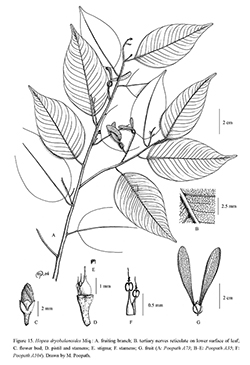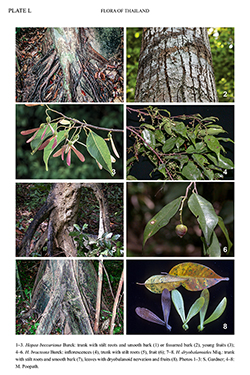e-Flora of Thailand
Volume 13 > Part 4 > Year 2017 > Page 596 > Dipterocarpaceae > Hopea
3. Hopea dryobalanoides Miq.wfo-0000724523
Fl. Ned. Ind., Eerste Bijv. 3: 492. 1861; P.S.Ashton, Fl. Males., Ser. 1, Spermat. 9: 402. 1982; Symington, P.S.Ashton & S.Appanah, Malayan Forest Rec. 16: 290. 2004; Poopath, Sookchaloem & Santisuk, Thai Forest Bull., Bot. 40: 69. 2012; Gardner, Sidisunthorn & Chayamarit, Forest Trees S. Thailand Vol. 1: 442, fig. 671. 2015.— Hancea dryobalanoides (Miq.) Pierre, Fl. Forest. Cochinch. 4, t. 244. 1891. Fig. 15. Plate L: 7–8.
Accepted Name : This is currently accepted.
Synonyms & Citations :
Description : Tree to 30 m tall, with stilt roots; bark smooth to slightly shallow fissured. Indumentum reddish brown peltate scales on young twigs, inflorescences and calyx. Stipules oblong, ca 2.5 by 1 mm, tomentose. Leaves ovate to ovate-lanceolate, 5–8 by 2.5–4 cm, glabrous, turning yellow before falling off, dried leaves brownish black; base acute to obtuse, slightly oblique; apex acuminate, to ca 1 cm long; nervation dryobalanoid, main nerves 9–10 on each side, a basal pair distinct, reaching to ca one third of the leaf length; domatia on lower part, pubescent; intermediate nerves present; tertiary nerves reticulate; midrib raised on both surfaces; petioles 0.6–1 cm long, sparsely pubescent to glabrous. Inflorescences erect, 2.5–3 cm long, pubescent; flower bud ovate-oblong, 4 by 2 mm; pedicels 1.5–2 mm long. Calyx lobes suborbicular, 1.2 mm long, with acute apex, pubescent outside and at tip inside. Petals falcate-oblong, ca 5 by 2 mm, white to yellowish. Stamens 15, in 2 whorls; filaments 0.5–0.8 mm long; anthers subglobose, ca 0.2 mm long; connective-appendages ca twice as long as anthers, sparsely glandular papillose towards base. Ovary ovoid, ca 0.8 by 0.4 mm, glabrous; stylopodium absent; style slender, ca 0.8 mm long, sparsely setose in lower half. Fruiting calyx lobes glabrous; 2 lobes wing-like, 3.5–6 by 0.5–1.5 cm, narrow and thickened at base, to 7 by 3 mm; veins 5–9; light green when young, turning yellow; 3 short lobes ovate, 0.8–1 cm long; fruit pedicels 1.5–2 mm long. Nut broadly ovoid, 0.7–1 by 0.5–0.7 cm, glabrous; stylopodium remnant to 1.5 mm long.
Thailand : PENINSULAR: Yala (Than To, Bannang Sata).
Distribution : Peninsular Malaysia, Sumatra (type), Borneo.
Ecology : Lowland evergreen forests, hillsides or ridges, 150–600 m alt. Flowering: April; fruiting: July–October.
Vernacular : Takhian sam sen (ตะเคียนสามเส้น).
Notes: Hopea dryobalanoides is closest to H. latifolia (domatia absent, connective-appendages ca as long as anthers, without stylopodium), H. pedicellata (secondary nerves 11–16 on each side, distinct stylopodium) and H. beccariana (distinct stylopodium, young twigs waxy glaucescent, fruiting calyx lobes reddish pink when young).


